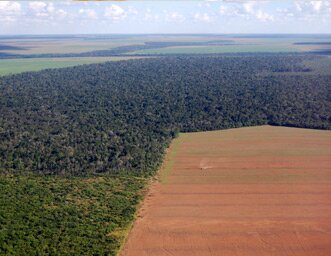The soybean is an extremely versatile commodity. It’s used for vegetable oil, as a source of protein in meat and dairy substitutes, and as a hidden ingredient in many processed food products. Overwhelmingly, though, it is found in livestock feed, and global demand is rising fast as meat consumption continues to grow, particularly in China. Brazil is on the point of overtaking the US as the world’s largest soy producer and exporter and production is booming along the southern border of the Amazon rainforest, where the low cost of deforested land makes production highly competitive.
Supply
| • | The major soy producing nations are the United States, Brazil, Argentina, China and India. Large tracts of low cost, fertile land and lower labour costs have fuelled the growth of South America’s soy industry and Brazil is expected to become the world’s largest producer for export. |
| • | In 2004-5, Brazil produced over 50 million tonnes of soy across nearly 23 million hectares - an area roughly the size of Great Britain. Between 1999 and 2004 soy production in the Amazon region increased by 15% per annum. 32% of Brazilian soy exports go to Europe. |
Demand
| • | •Soy’s primary role in the global food industry is as a feedstock in intensive animal husbandry for meat, dairy or egg production. It is estimated that 80% of the world’s soy production is fed to livestock – primarily cows, pigs and chickens. |
| • | Much of Europe’s meat production is now dependent upon soy as a feedstock. In 2007, the European Union’s 27 countries together imported over 24 million tonnes of soy meal, 15 million tonnes of soybeans (almost all of which were also processed into feedstock on arrival) and almost 1 million tonnes of soy oil. These products are mainly fed to pigs and poultry that are sold on as meat and used in multiple food products eaten by millions of people every day. There is presently little awareness among consumers of the forest footprint this is creating. |
| • | Despite significant domestic production, China is now the world’s biggest importer of soy to feed its growing livestock sector. The per capita consumption of pork in China has almost doubled since 1990 – growing from 20 to 40 kg – according to the China Meat Association. Meanwhile the growth of dairy consumption in India and the corresponding need for feedstock is challenging the country’s ability to sustain soy exports. |
| • | In Europe, soy is also used in 60% of processed food – including cereals, biscuits, cheeses, cakes, noodles, pastries, soups and spreads – and the sector is growing rapidly worldwide. |
| • | Taken together, these upward pressures are expected to increase global demand for soy from 200 million to 300 million tons by 2020. Further development of the soy industry at this scale can only realistically come from increasing yield on available land rather than increasing the hectares under cultivation. |
Land conversion
| • | Brazil is the fourth largest emitter of greenhouse gases globally, and 75% of its emissions are caused by deforestation. |
| • | In 2006 the Brazilian Vegetable Oil Industry Association (ABIOVE) and the Brazilian Grain Exporters Association (ANEC), pledged not to trade soy from newly deforested areas in the Amazon. Originally agreed for 2 years, this initiative, known as the “Soy Moratorium”, has been extended to July 2009. |
| • | This initiative has dramatically reduced land conversion within the Amazon region. Results of verification using satellite-based mapping and monitoring were officially announced at the Ministry of the Environment in Brasília in April 2009, and showed that of a total of 630 selected areas in which some deforestation had taken place since July 2006, soy was being grown in only 12. |
Extent of 3rd party certification
| • | The Roundtable on Responsible Soy (RTRS) is a multi-stakeholder process with a secretariat in Argentina, an Executive Board and a membership divided between producers, traders, financiers and civil society. The RTRS is developing a set of principles and criteria for responsible soy production together with requirements for certification and a programme to support capacity within the soy sector. |










